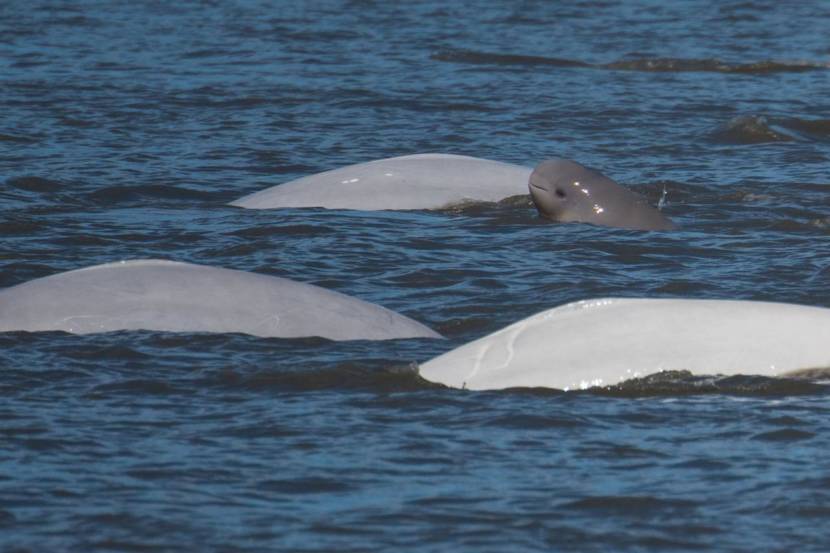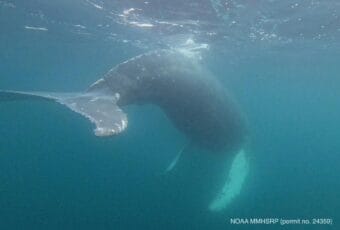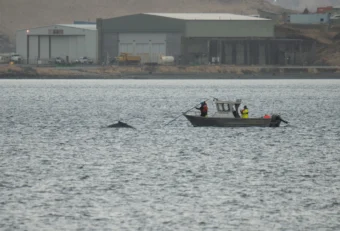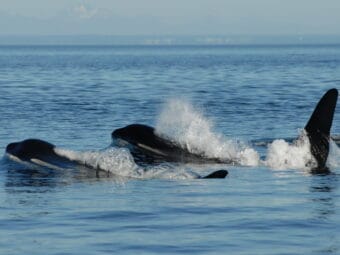
Those who live close to the Kenai and Kasilof rivers know belugas sometimes feed there. But it’s been a mystery how many whales actually travel through those waterways, particularly in the spring.
This year, a large team of volunteer observers counted for the first time how many Cook Inlet belugas passed through the rivers between March and May. They counted just over 220 belugas.
“They are absolutely amazing. Absolutely amazing,” said Teresa Becher, a coordinator for the Alaska Beluga Monitoring Partnership. She was among a team of nearly 30 observers that scanned the Kenai and Kasilof rivers this spring for Cook Inlet belugas — a population that’s considered critically endangered and has been declining for over two decades.
Researchers are tracking Cook Inlet belugas to learn more about why they aren’t rebounding.
They’ve relied in part on volunteers like Becher who count and report beluga sightings in Cook Inlet and its watershed. For a few years, they’ve watched whales in the fall, when they come into the rivers for silvers.
But they haven’t been tracking as closely what happens when belugas return to the rivers in the spring, until this year.
“One of the biggest things that we learned is that the belugas use the Kenai River in particular much more often than even NOAA understood in terms of coming in and foraging for food in the spring,” Becher said.
She said they saw the first belugas in the rivers on March 25 and the last on April 30.
“And to discover that they use the Kenai River so much during the spring is very important information,” she said. “It just means that we really have to pay attention to what’s going on in the river and kind of find out what it is they’re eating.”
Becher counted from the river bluff in Kenai. Up at Turnagain Arm, Suzanne Steinert was counting by the Twentymile River and near the Mile 95 pullout in Girdwood.
“We call that stretch there Beluga Alley,” she said.
Monitors in the inlet saw fewer whales than in the rivers. But Steinert said they got to observe some interesting beluga behaviors — like when a pod of belugas swam up to a stranded humpback whale in Turnagain Arm.
“It was really fascinating. Personally, I had never seen belugas interacting with a whale like that in Turnagain Arm,” Steinert said.
Monitors at all the locations submitted their observations electronically and they’ll be compiled by a coordinator. That data is cross-referenced with data from aerial surveys from the National Oceanic and Atmospheric Administration.
It’s one part of a large puzzle about the endangered animals. And there are still lots of pieces researchers don’t know, like why the belugas travel through the rivers in the spring. They’re trying to learn more about the belugas’ food sources through an environmental DNA project this year.
Becher said she wants to learn more about what’s threatening the beluga population as a whole.
“One of the big problems that NOAA talks about is they have not been able to pinpoint why they aren’t coming back,” she said. “Is it pollution? Is it warming temperatures? No one seems to know.”
Belugas do sometimes come into contact with boats and fishermen — something Becher said they can better avoid if they know where belugas are. The Alaska Wildlife Alliance has a text alert system so people know when there’s been a sighting.
“That’s probably the single most important, immediate thing that everyone can help with,” she said.
It’s hard to say if the large number of whales in the rivers are a sign that the population is rebounding, since there’s little data for comparison. It’s also possible observers counted some whales twice. Scientists know of about 280 Cook Inlet belugas in existence.
But Becher said they’ll use this year’s counts as a benchmark going forward.
To get text alerts about belugas in the Kenai and Kasilof Rivers text BELUGA to 833-541-0408.



